Vintage Cable Box June 1984: The Dark Crystal/Spacehunter: Adventures in the Forbidden Zone
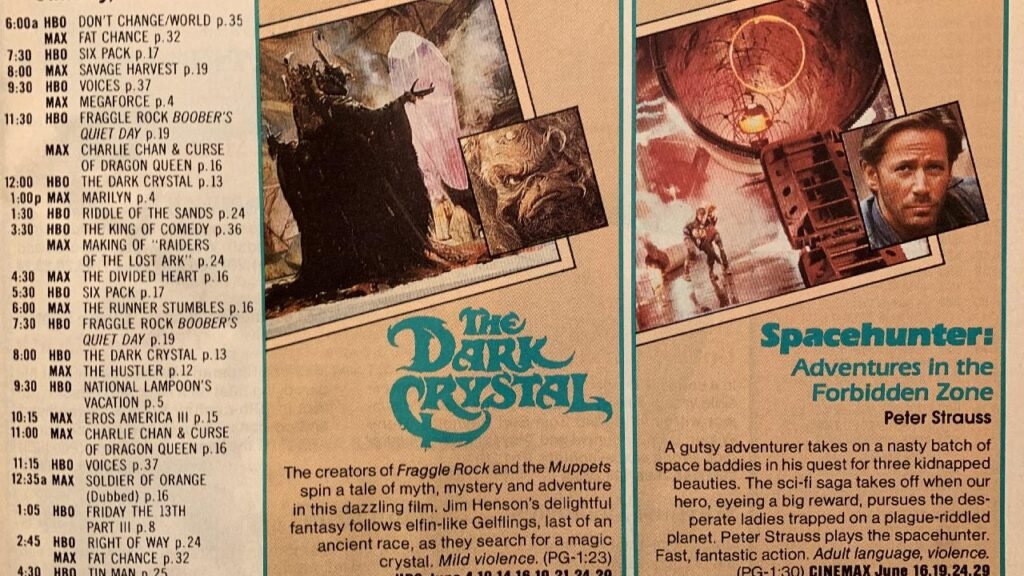
The Dark Crystal, 1982 (Stephen Garlick/Lisa Maxwell) Universal Pictures
Even on an unconscious level, the storytelling of Star Wars was on the minds of most, if not all, filmmakers after 1977. For those who failed at the coming of Lucas’ Jedi odyssey, like the recently-passed William Friedkin and his Sorcerer, Star Wars still remained. Like an itch. The influence was such that it spread even to rock music. Triumph of an underdog; a well-worn but exuberant staple, as well as an example of Joseph Campbell’s Hero with a Thousand Faces.
Even Lucas couldn’t rid himself of his own phenomenon. Willow, from 1985, starring Val Kilmer and Warwick Davis, is a rough retread of Star Wars. Jim Henson and Frank Oz (with Lew Grade’s ITC) put together The Dark Crystal, produced by Gary Kurtz and written by David Odell from a story by Henson. This is another hero’s journey. A young Gelfling named Jen must find a broken crystal’s shard in order to “heal” an even larger crystal (the “Crystal of Truth”) and somehow cause the evolution of a species of benevolent nomad (known as urRu) as well as defeat the evil rat/bat-like Skeksis.
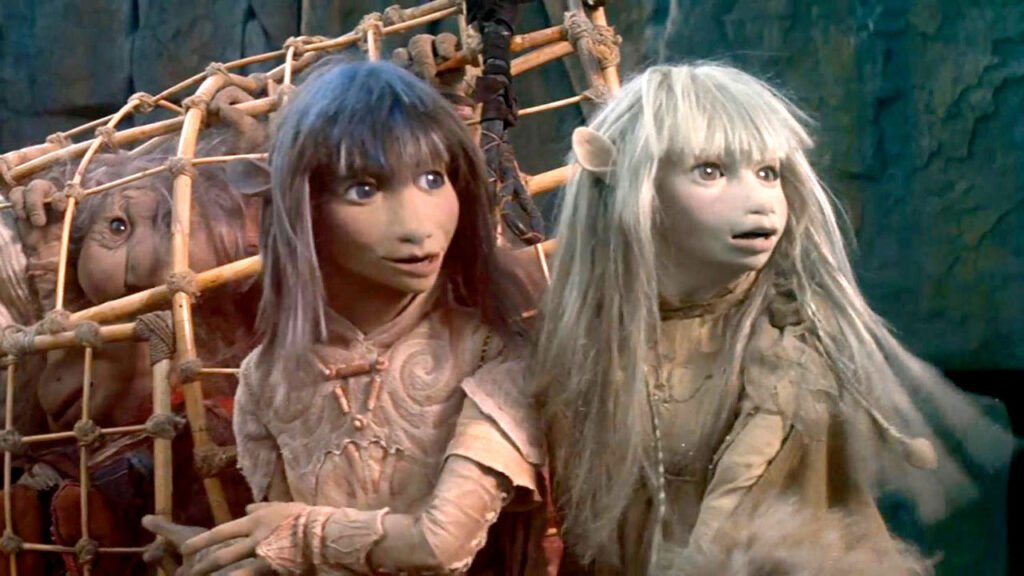
During the journey, he finds a pretty female Gelfling named Kira. It’s revealed that when the crystal shattered, two separate species were created, and as such, the urRu and the Skeksis share a common lineage. You can pretty much guess what happens when the shard is reunited with the larger crystal. I rather like the message of the movie. Rather than ending in lasers and exploding space stations, the film ends on a note of peace and optimism.
I wonder if this isn’t a spin on Jung’s theory of duality. The urRu, while peaceful, are also benign and harmless thus requiring a young warrior-type to save their collective bacon. The Skeksis are “evil,” therefore they are motivated to protect themselves, but there are also visual prejudices. The urRu look wise. The Skeksis are ugly. The Gelfling are beautiful and whisper-thin. I spent the entire movie trying to figure out what Jen and Kira look like.
I think it came down to Michael Beck (from The Warriors and Xanadu) and country rock singer Juice Newton. So, for the purposes of this review, try to imagine Michael Beck and Juice Newton as puppets. The creatures of The Dark Crystal are not quite Muppets. They’re probably made of the same materials, and some are inhabited as life-sized costumes. The production design is staggering to look at, and sometimes we’re not sure if we’re looking at miniatures or full-size sets.
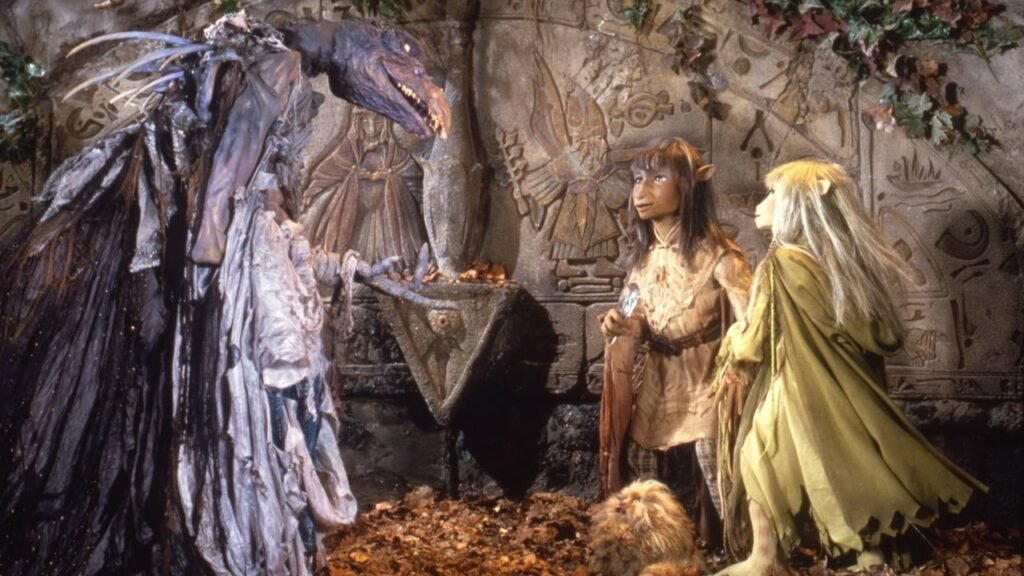
Remember, all of this was done without computers and CGI. This is a handmade film from start to finish, but it was denied any Academy Award nominations. It’s interesting that there are only two major plot points (Jen’s journey and resolution) and Jen’s odyssey is fairly brief. It seems like chunks of the movie were removed to trim the running time. There’s a lot more going on in this ninety-minute film than in most two-and-a-half hour films being produced these days.
I’ve been looking at old movies (really old, going back to the ’30s) and I noticed that movies being made back then had much shorter running times; fifty to seventy minutes. Moving forward into the ’50s through the ’70s, the average running time was a little over ninety minutes. Storytelling was concise and economical. In the ’80s, longer running times were reserved for “big sky” and biographical epics like Gandhi and Out of Africa. These days, it seems, every movie is topping out over two-and-a-half to three hours. Even barely watchable Batman movies. The Dark Crystal has an “epic” feel, but it is an abbreviated journey.
Spacehunter: Adventures in the Forbidden Zone, 1983 (Peter Strauss), Columbia Pictures
Three babes straight out of a Poison music video crash land on a planet of freaks who abduct them, as love-starved freaks are want to do. I’ve never understood that. Are women some incredible commodity in the future (or even in a galaxy far, far away)? Enter Wolff (Peter Strauss), a carbon-copy Han Solo, who picks up on a message rewarding a lot of money (or “credits” as the case may be) for the safe return of the heavy metal babes.
His hot android engineer, Chalmers (Andrea Marcovicci) activates the drive system (if you know what I mean— heh) and they’re off to collect some space booty. Wolff’s ship houses a spiffy all-terrain vehicle that recalls James Cameron’s Aliens. The big problem is that Strauss seems too cultured (especially with his scholarly voice) to be a no-good, son-of-a-bitch, bastard salvage operator and part-time pirate. Maybe he was a disgraced Sociology professor.
They land on the alien babe planet in the middle of a skirmish. The visuals are strictly Mad Max, and it occurs to me now there was some effort set aside to make this a serious science fiction movie. Chalmers is killed (or deactivated) and the babes are taken away, but that doesn’t stop Wolff from finding his quarry. The alien freaks in this movie remind me of the mutants who crash Wyatt’s party at the end of Weird Science.
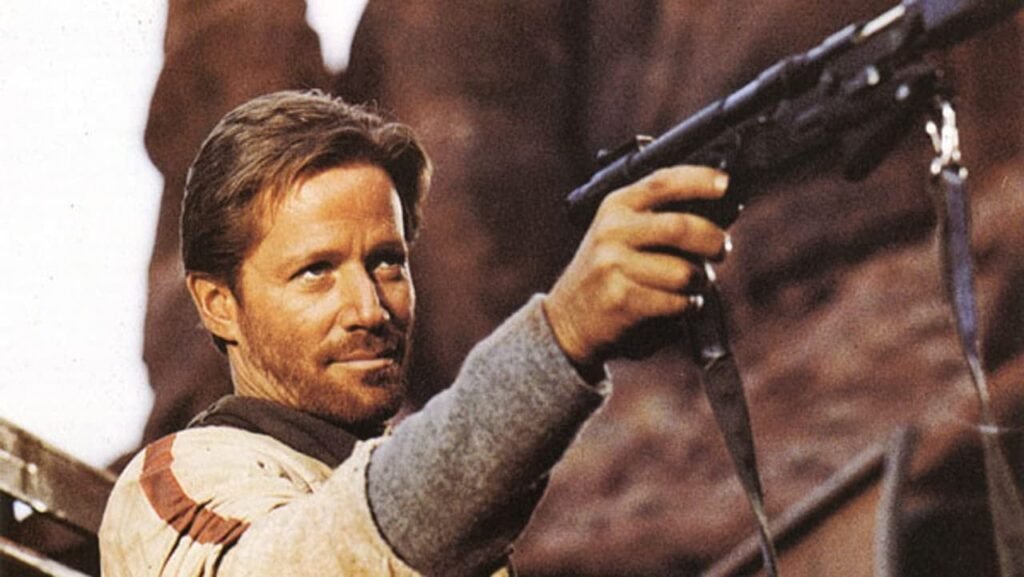
Scrappy foul-mouthed (and stinky) orphan Molly Ringwald tries to steal Wolff’s wheels, but apparently, she can’t drive a stick (a common problem with space orphans). With the promise of food, he takes her along as an adviser on the mysterious freak planet. Sick of her stench, he throws her in a lake and dumps soap all over her. Wolff hooks up with fellow countryman, Washington (Ernie Hudson) who offers a partnership to find the space babes, but nothing comes of it. What?
Dispensing with Hudson’s character keeps the clash between Strauss and Ringwald more entertaining. Of course all of this tension is meant to make us like the characters. Wolff, up until the point he saves a malnourished Molly Ringwald (the both of them suffering dehydration on a planet of poisoned water), comes over as an insufferable prick, but I blame the humor producer Ivan Reitman and his recruited writers, Len Blum and Daniel Goldberg, injected into David Preston and Edith Rey’s otherwise somber first draft.
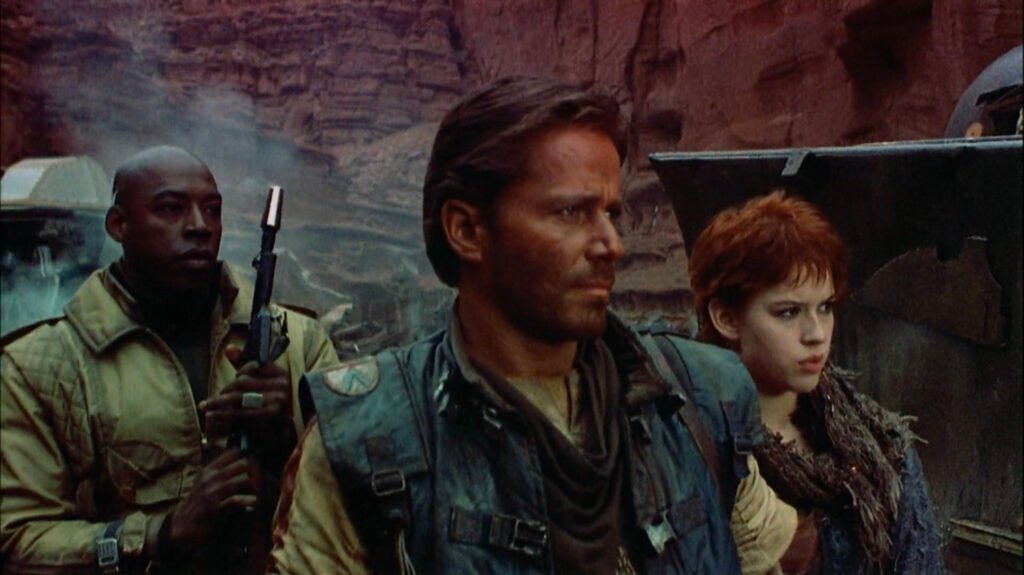
The script obviously parodies 2001: A Space Odyssey, Barbarella (itself a parody), Star Wars, Buck Rogers, and the Mad Max movies, but the material would’ve better served the comic timing of a Bill Murray or a Dan Aykroyd. Indeed, with Elmer Bernstein’s music, Spacehunter plays like a precursor to Ghostbusters. Meanwhile we have the great Michael Ironside (who really doesn’t need ghoulish makeup to look ghoulish) as some kind of a hideous, spider-robot creature with a taste for hot alien space babes, because why not?
In the end, Wolff rescues Molly and the space babes (with an able assist by Hudson) and dispatches Ironside, but the story feels lop-sided. Like 48 Hrs., we spend more time getting to know our protagonists than we do understanding or assessing Ironside’s motivation; as a spider-robot thing, he needs life essence to function and only women will do. Works for me! This is another in a series of hip and goofy space comedies such as Ice Pirates and the Reitman-produced/Goldberg and Blum written Heavy Metal made two years previous.
While the movie was originally photographed and shown in 3-D, the film elements removed from the process hold up surprisingly well. In fact, this is one of the better-looking 2-D movies (even with some very cheesy animated visual effects) made from 3-D, unlike Jaws 3D and The Man Who Wasn’t There. Director Lamont Johnson directed several episodes of the classic Twilight Zone television anthology series, including “The Shelter” and “Kick the Can.”
Our first cable box was a non-descript metal contraption with a rotary dial and unlimited potential (with no brand name – weird). We flipped it on, and the first thing we noticed was that the reception was crystal-clear; no ghosting, no snow, no fuzzy images. In June of 1984, HBO and Cinemax broadcast an incredible, eclectic assortment of movies. Vintage Cable Box returns to highlight each of those movies, as well as offering new appraisals and providing context into what was cable television in the mid ’80s. It was a different cultural landscape at the time, and these movies offered an education that went far and above film school. Vintage Cable Box explores the wonderful world of premium Cable TV of the early eighties. Enjoy!
Special thanks to Dave Hooser for scanning the HBO/Cinemax guide and sharing these pictures.

